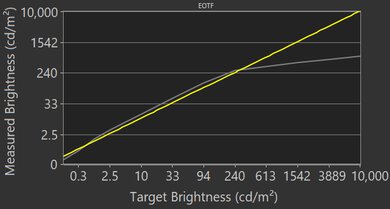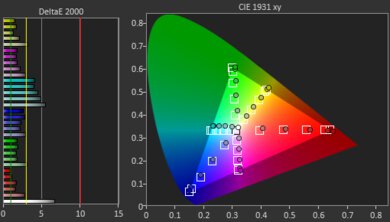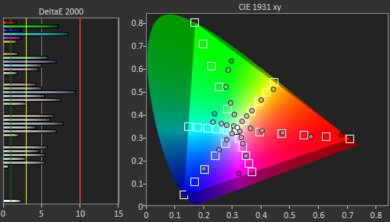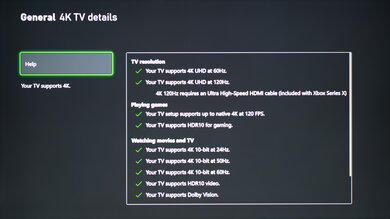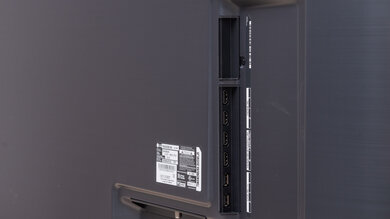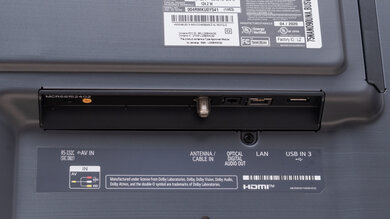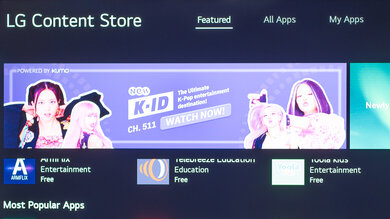The LG NANO90 2020 is a good overall TV in LG's NanoCell series. It has an IPS panel with fairly wide viewing angles, but that comes at the cost of a low contrast ratio and mediocre black uniformity. It has a full-array local dimming feature which improves the contrast a bit, but its performance is quite disappointing. Gamers should appreciate its great response time, low input lag, and 120Hz panel. It also has variable refresh rate (VRR) support to reduce screen tearing. Although it doesn't get very bright, it has impressive reflection handling, so you shouldn't have any issues placing it in moderately-lit rooms. Sadly, HDR content doesn't look very good because it doesn't get bright enough to truly bring out highlights.
Our Verdict
The LG 75NANO90UNA is a good overall TV. With its IPS panel, it provides fairly wide viewing angles, which is ideal for watching TV shows, sports, or using it as a PC monitor. It's also great for gaming because it has a quick response time, low input lag, and VRR support. It has a low contrast ratio and mediocre black uniformity, so it's not a good choice for watching movies or gaming in the dark. HDR content doesn't look great either, as it doesn't get bright enough to bring out highlights.
- Fairly wide viewing angles.
- Excellent low input lag.
- Impressive reflection handling.
- Low contrast ratio.
- Doesn't bring out highlights in HDR.
- Doesn't get very bright.
The LG 75NANO90UNA is decent for watching movies. Due to its IPS panel, it has a low contrast ratio. Luckily, it has a full-array local dimming feature that improves the contrast, but it doesn't handle transitions between the dimming zones well. This TV upscales 1080p content well and it can remove judder from any source.
- Removes judder from any source.
- Full-array local dimming feature.
- Low contrast ratio.
- Mediocre black uniformity.
The LG 75NANO90UNA is good for watching TV. It has fairly wide viewing angles, so you get an accurate image when viewed from the side, which is good if you tend to walk around while watching your favorite show. It has impressive reflection handling but doesn't get bright enough to combat glare in a well-lit environment. Also, it upscales lower-resolution content without any issues, such as from cable boxes.
- Fairly wide viewing angles.
- Impressive reflection handling.
- Doesn't get very bright.
The LG 75NANO90UNA is very good for sports. It has a quick response time that results in smooth motion, and there's a Black Frame Insertion feature to improve clarity. It has fairly wide viewing angles and performs well in moderately-lit rooms because of its impressive reflection handling, but it doesn't get very bright. It doesn't have any issues upscaling 720p content from cable boxes.
- Fairly wide viewing angles.
- Impressive response time.
- Impressive reflection handling.
- Visible dirty screen effect.
- Doesn't get very bright.
The LG 75NANO90UNA is good for video games. It has a great response time, a Black Frame Insertion feature, and a really low input lag. It's not ideal for dark-room gaming because it has a low contrast ratio, but in bright rooms, it has impressive reflection handling. It also has VRR support to reduce screen tearing.
- Excellent low input lag.
- Impressive response time.
- Full-array local dimming feature.
- Low contrast ratio.
The LG 75NANO90UNA is okay for HDR movies. It supports HDR10 and Dolby Vision, displays a wide color gamut for HDR content, but it doesn't get bright enough to truly bring out highlights. It also has a low contrast ratio and mediocre black uniformity, so it's not ideal for watching movies in the dark. However, it has a full-array local dimming feature that improves the contrast.
- Removes judder from any source.
- Low contrast ratio.
- Doesn't bring out highlights in HDR.
The LG 75NANO90UNA is very good for HDR gaming, mainly due to its great gaming performance. It has a very low input lag and its quick response time results in minimal motion blur. It has VRR support to reduce screen tearing. Sadly, HDR content doesn't look good on this TV because it doesn't get bright enough to bring out highlights.
- Excellent low input lag.
- Impressive response time.
- Low contrast ratio.
- Doesn't bring out highlights in HDR.
The LG 75NANO90UNA is an excellent choice to use as a PC monitor. It displays chroma 4:4:4 with a 1080p or 4k resolution, which is important for reading text. It has fairly wide viewing angles, so the edges of the screen don't look washed out if you sit too close. It has impressive reflection handling, but it doesn't get bright enough to combat glare in a well-lit environment.
- Fairly wide viewing angles.
- Excellent low input lag.
- Displays proper chroma 4:4:4.
- Visible dirty screen effect.
- Doesn't get very bright.
Changelog
- Updated Jul 19, 2021: We added two new videos demonstrating the local dimming feature with real content. We also retested local dimming in Game Mode and found that it doesn't work when FreeSync is in use.
- Updated Jun 16, 2021: Retested the TV with a RTX 3080 graphics card to check if G-SYNC works up to 120Hz.
- Updated Mar 01, 2021: Converted to Test Bench 1.6.
- Updated Dec 10, 2020: Updated the firmware and retested FreeSync support.
Check Price
Differences Between Sizes And Variants
We tested the 75 inch LG NANO90 2020 (75NANO90UNA), and for the most part, we expect our results to be valid for the 55 inch (55NANO90UNA), 65 inch (65NANO90UNA), and 86 inch (86NANO90UNA) variants as well. The European variants have different model numbers than the American ones, which are listed below.
| Size | US Model | EU Model |
| 55" | 55NANO90UNA |
55NANO906NA |
| 65" | 65NANO90UNA |
65NANO906NA |
|
75" |
75NANO90UNA |
75NANO906NA |
| 86" | 86NANO90UNA | - |
If someone comes across a different type of panel or if their LG NANO90 2020 doesn't correspond to our review, let us know and we'll update the review. Note that some tests, such as the gray uniformity, may vary between individual units.
The unit we tested was manufactured in April 2020 and you can see the label here.
Popular TV Comparisons

The LG NANO90 2020 is a good overall upper-mid range TV. Its IPS panel provides fairly wide viewing angles, although they're not as wide as some other TVs. It has a full-array local dimming feature, which is a nice touch, but it doesn't produce the same deep blacks as VA panel TVs. Overall, it's a slight upgrade over its predecessor, the LG SM9000 and most people should be happy with this TV. Also see our recommendations for the best LED TVs, the best 70-75-77 inch TVs, and the best TVs for watching TV shows.
The LG NANO90 2021 and the LG NANO90 2020 are both good TVs. The 2021 model improves in some areas, like the peak brightness, gradient handling, and build quality, and it also has a redesigned interface. The 2020 model displays a wider color gamut for HDR content, but not by much. Overall, the picture quality between each is very similar, and it's unlikely you'll notice any differences.
The LG NANO90 2020 is much better the LG NANO81. The NANO90 has a higher 120Hz refresh rate and has variable refresh rate support. It also supports Dolby Vision, has a wider color gamut, better built-in speakers, and it gets brighter. On the other hand, the NANO81 has a lower input lag, it handles reflections better, and it also wider viewing angles.
The Sony X900H is better overall than the LG NANO90 2020. The Sony has a VA panel, producing much deeper blacks, and it has a better full-array local dimming feature. It also gets brighter, has more accurate colors, and it has a more uniform screen. However, the LG has wider viewing angles due to its IPS panel, so it may be preferable if you have a wide seating arrangement.
The Samsung Q70T and the LG NANO90 2020 are both good TVs with different panel types. The Samsung has a VA panel that allows it to display much deeper blacks than the LG, so it's better suited for watching movies in dark rooms. However, the LG's IPS panel has wider viewing angles, making it a better choice for wide seating areas.

We buy and test dozens of TVs yearly, taking an objective, data-driven approach to deliver results you can trust. Our testing process is complex, with hundreds of individual tests that take over a week to complete. Most of our tests are done with specially designed test patterns that mimic real content, but we also use the same sources you have at home to ensure our results match the real-world experience. We use two main tools for our testing: a Colorimetry Research CR-100 colorimeter and a CR-250 spectroradiometer.
Test Results

The LG 75NANO90UNA has an excellent design that's different from 2019's LG SM9000. It looks a lot like the LG NANO85 2020 and it has thin bezels on three sides. It has two wide-set feet as its stand, somewhat of a downgrade from the stylish center-mounted stand on the SM9000. Overall, it's a simple-looking TV that doesn't stand out much.
The stand is different from its predecessor, the LG SM9000. Instead of a center-mounted stand, it has two feet that sit at the edge of the TV, so you're going to need a wide table to place it on. There's enough space to put a soundbar in front of it too.
Footprint of the 75" TV: 56.9" x 14".
Update 08/17/2020: We confirmed the back panel is made out of metal, and not plastic, as we previously stated. The review has been updated.
The back is made out of smooth metal and it has a simple design. There are downward and side-facing inputs, and there are hooks on the feet that serve as cable management.
Update 08/17/2020: We confirmed the back panel is made out of metal, and not plastic, as we previously stated. The review has been updated.
This TV has a decent build quality. It's made out of metal and plastic that feels cheap and there's nothing premium about it. Still, the overall build is solid and the TV is held together well. There's not a lot of wobble, especially for a TV of this size. Lastly, the inputs flex a bit, but this shouldn't be an issue for most people.
The contrast ratio isn't bad for an IPS panel TV, but this may vary between units. It's similar to other LG TVs we've seen in the past, but it's not as good as the LG NANO85 2020. Still, blacks appear closer to gray, which is noticeable in a dark room. It has a full-array local dimming feature that improves the contrast ratio. If you want a TV with an exceptional contrast ratio, see the Samsung Q70/Q70A QLED.
The LG 75NANO90UNA has just okay peak brightness in SDR, very similar to the LG NANO85 2020. It quickly loses brightness when large, bright areas cover the screen, which is likely caused by its Automatic Brightness Limiter (ABL). If you want a similar-performing TV that gets much brighter, then check out the Samsung Q80/Q80A QLED.
We measured the peak brightness after calibration on the 'Expert (Dark Mode) Picture Mode, with Brightness and Contrast set to 'Max', and Local Dimming on 'Medium'. The brightest the TV got was with these settings, as seen in the 10% peak window test.
Update 07/19/2021: We've added two new videos demonstrating the local dimming feature with real content.
The LG 75NANO90UNA has a full-array local dimming feature, but it's quite disappointing. When there are small, bright objects moving across the scene, the dimming zones don't transition quickly, and you see the transitions happening, which could be distracting. Also, since it's an IPS TV with a low contrast ratio, blacks still look gray. On the upside, it handles subtitles well as there isn't noticeable blooming. We recommend setting Local Dimming to 'Medium', but even with this setting, there are still issues as small light sources don't pop at all, and it crushes dark scenes.
Update 07/19/2021: We've added two new videos demonstrating the local dimming feature with real content.
Update 07/19/2021: We retested the local dimming feature in Game Mode based on user feedback. We found that the local dimming feature is disabled whenever FreeSync is in use from a native FreeSync source, like an AMD graphics card, but it works fine when connected to a G-SYNC source. This is most likely a bug, but we don't know for sure.
This TV has unremarkable peak brightness in HDR. Once again, the LG 75NANO90UNA loses brightness with large areas, as seen in the difference in brightness in the 10% and 100% peak window tests. This TV doesn't get bright enough to truly bring out highlights in HDR. If you want something brighter, check out its replacement, the LG NANO90 2021.
We measured the peak brightness before calibration on the 'Cinema' Picture Mode, with Brightness and Contrast set to 'Max', and Local Dimming on 'Medium'.
If you want the brightest image possible, use the 'Vivid' Picture Mode with Local Dimming set to 'Medium'. We were able to get 692 nits on the 10% peak window test, but even this peak brightness only lasted a few seconds before it dropped to about 320 nits.
The gray uniformity is just okay, but this may vary between units. The edges of the screen are visibly darker and there's some noticeable dirty screen effect in the center, which could be distracting while watching sports. The uniformity is much better in dark scenes.
The black uniformity is mediocre, but this may vary between units. Without local dimming, there's clouding throughout and visible backlight bleed in the corners, especially at the bottom left, which is a bit hard to see in the picture. With local dimming on, the entire screen is more black but there's more blooming around the center cross.
The LG 75NANO90UNA has okay viewing angles. This isn't as good as most IPS TVs, as the image quickly loses brightness when moving off-center. However, you still get a fairly accurate image when viewing from the side so it's a decent choice for a moderately-sized room.
This TV has impressive reflection handling. It performs well in moderately-lit rooms, and even with direct light on it, the reflections don't get too distracting. You shouldn't have any problems placing the LG 75NANO90UNA in a bright room.
The out-of-the-box color accuracy is decent, but this may vary between units. Most colors are a bit inaccurate and the color temperature is a bit warmer than the 6500K target, giving the image a red/yellow tint. Sadly, white balance is off and gamma also doesn't follow the curve very well, so most scenes are too dark.
After calibration, the LG 75NANO90UNA has outstanding color accuracy. Any remaining inaccuracies aren't visible without the aid of a colorimeter. The gamma also follows the curve almost perfectly. Sadly, the color temperature is a bit too cold, giving the image a blueish tint.
See our recommended settings here.
The LG 75NANO90UNA has a very good wide color gamut, similar to the LG SM9000 and a bit better than the LG NANO85 2020. It has excellent coverage of the commonly-used DCI P3 color space but it has limited coverage of the wider Rec. 2020 color space. The EOTF follows the curve well until it rolls off at its peak brightness, but most scenes are still a bit over-brightened. The EOTF in 'Game' mode is very similar.
If you find HDR too dim, set the Picture Mode to 'Vivid', Local Dimming to 'High', and both Brightness and Contrast to 'Max'. This results in a noticeably brighter image, as seen in this EOTF.
The LG 75NANO90UNA has alright color volume. Due to the low contrast ratio, it can't display dark colors well and like most LED TVs, it can't display bright blues.
The gradient handling is decent, but sadly, not as good as the LG SM9000. There's noticeable banding in red and even more so in gray. Enabling the Smooth Gradiation doesn't affect the test pattern but it makes real content look better.
There's some very minor temporary image retention immediately after display our high-contrast static image for 10 minutes. This could vary between units and it has nothing to do with the permanent burn-in associated with long-term exposure to static images.
While some IPS panels like this have some temporary image retention, this doesn't seem to be permanent as the IPS panel in our long-term test appears to be immune.
The LG 75NANO90UNA has a great response time. There's some overshoot in the darker transitions, but overall, motion looks smooth. This is a significant improvement over the LG SM9000.
The LG 75NANO90UNA is flicker-free only when the backlight is at 100% brightness. Otherwise, it flickers at 960Hz, which is so high that it shouldn't be noticeable for most people. The backlight flickers at 120Hz when TruMotion is enabled and at 60Hz with the Black Frame Insertion feature enabled.
The LG 75NANO90UNA has a Black Frame Insertion feature to help improve the appearance of motion. It flickers at 120Hz with TruMotion enabled in 'Game' mode, and it flickers at 60Hz, with the Motion Pro setting enabled. The BFI feature doesn't actually doesn't clear up motion blur as much as other TVs.
Find out more about the NANO90's Black Frame Insertion feature here.
The LG 75NANO90UNA can interpolate motion up to 120fps, known as the 'Soap Opera Effect'. To turn it on, set De-Judder and De-Blur to 'Max' in the TruMotion settings. It does an okay overall job with motion but in action-packed scenes, there are some artifacts. However, it's not very distracting and shouldn't be noticeable with most content.
Since the LG 75NANO90UNA has such a fast response time, there's some stutter as each frame is held on longer. You can reduce the amount of stutter by enabling the motion interpolation feature.
The TV can remove judder from any source, such as Blu-ray players or native apps. To remove judder, turn on Real Cinema.
Update 06/16/2021: We retested the TV with our RTX 3080 PC and confirmed that VRR works up to 120Hz in 4k, including with G-SYNC. There aren't any issues with it and it's tear-free across its entire range.
Update 12/10/2020: We updated the firmware to 03.21.10 and tested the FreeSync support. It works properly and there aren't any issues. We tested it with our Radeon PC, so we couldn't test if 4k VRR goes up to 120Hz.
Update 11/27/2020: We retested the TV with a HDMI 2.1 source.
The LG 75NANO90UNA has a high 120Hz refresh rate. It supports HDMI Forum VRR and FreeSync natively, and it's G-SYNC compatible. It doesn't have any issues with the VRR support at any resolution and there's no screen tearing.
Update 12/10/2020: We updated the firmware to 03.21.10 and measured the VRR input lag.
Update 11/27/2020: We retested the TV with a HDMI 2.1 source. It displays 4k @ 120Hz, but there are some issues. It crashes with VRR enabled when connected to an NVIDIA RTX 3080, but works fine with the Xbox Series X. We couldn't measure the VRR input lag because of the way it kept crashing.
The LG 75NANO90UNA has an excellent low input lag, as long as you're in 'Game' mode. It has an 'Auto Low Latency' mode that detects when a compatible gaming console is connected, and automatically switches to 'Game' mode to ensure the lowest possible input lag. For this to work, turn on Instant Game Response.
If you want to use it as a PC monitor and get the lowest input lag possible, set the input icon to 'PC' and use 'Game' mode.
Update 11/27/2020: We retested the TV with a HDMI 2.1 source. It had issues when connected to our NVIDIA RTX 3080 and couldn't display chroma 4:4:4. We had to keep restarting the TV for it to display 4:4:4, but we consider 4k @ 120Hz @ 4:4:4 unusable because of these problems. However, it didn't have any issues displaying 4k @ 120Hz with our Xbox Series X.
The LG NANO90UNA supports most common resolutions, including 4k @ 120Hz on HDMI inputs 3 and 4. It can display proper chroma 4:4:4 at all resolutions except 4k @ 120Hz, as it doesn't properly display it until we restart the TV and play with the settings. To get chroma 4:4:4, set the input icon to 'PC' from the home dashboard. For full-bandwidth signals, enable HDMI ULTRA HD Deep Color from the settings menu.
Update 11/27/2020: We retested the TV with a HDMI 2.1 source. HDMI 3 and 4 support HDMI 2.1 and 4k @ 120Hz, but have trouble with 4k @ 120Hz with our RTX 3080. However, there aren't any issues with the Xbox Series X.
The LG 75NANO90UNA supports 4k @ 120Hz on HDMI 3 and 4.
This TV supports eARC, allowing it to send high-quality uncompressed audio to a compatible receiver through an HDMI connection. For this to work, go to the Sound Out page in the 'Sound' settings menu, open HDMI ARC, turn eARC on and set Digital Sound to 'Passthrough'. Unfortunately, LG removed DTS decoding from their TVs in 2020.
This TV has decent frequency response. It has a fairly good bass for a TV, but to get the best bass possible, you should get a soundbar with a dedicated subwoofer. It has a fairly well-rounded sound profile, resulting in clear dialogue. It doesn't get extremely loud, so it's not ideal for noisy environments, and there's compression at its max volume.
The distortion performance is decent. The total harmonic distortion is almost inaudible at moderate listening levels but it gets significantly more noticeable when listening at its max volume. However, this depends on the content and not everyone may hear it. If you want a TV with speakers that cause less distortion, check out the Samsung The Sero.
The LG 75NANO90UNA has LG's WebOS, which is a slightly upgraded version from the LG SM9000. It's easy to use and there aren't any noticeable issues with it.
Like most LG TVs sold in 2020, the LG 75NANO90UNA comes with LG's Magic Remote. You can use it either as a traditional remote with its navigation buttons, or you can use it as a point-and-press remote, like a computer mouse. It has shortcut buttons to Netflix and Amazon Prime Video. It also has built-in voice control that allows you to search for specific content in apps, change the source, or ask for information like what the weather is.









